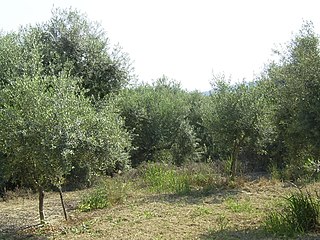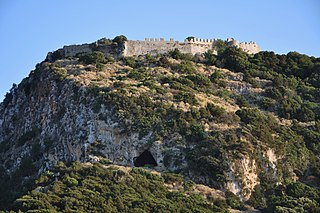Related Research Articles

Mystras or Mistras, also known in the Chronicle of the Morea as Myzethras or Myzithras (Μυζηθρᾶς), is a fortified town and a former municipality in Laconia, Peloponnese, Greece. Situated on Mt. Taygetus, near ancient Sparta, it served as the capital of the Byzantine Despotate of the Morea in the 14th and 15th centuries, experiencing a period of prosperity and cultural flowering during the Palaeologan Renaissance, including the teachings of Gemistos Plethon. The city also attracted artists and architects of the highest quality. The site remained inhabited throughout the Ottoman period, when Western travellers mistook it for ancient Sparta. In the 1830s, it was abandoned and the new town of Sparti was built, approximately eight kilometres to the east. Since the 2011 local government reform it is part of the Sparti municipality. As an exceptionally well-preserved example of a Byzantine city and because of its testimony to the development of Late Byzantine and Post-byzantine art, Mystras was inscribed on the UNESCO World Heritage List in 1989.

The Principality of Achaea or Principality of Morea was one of the vassal states of the Latin Empire, which replaced the Byzantine Empire after the capture of Constantinople during the Fourth Crusade. It became a vassal of the Kingdom of Thessalonica, along with the Duchy of Athens, until Thessalonica was captured by Theodore, the despot of Epirus, in 1224. After this, Achaea became for a while the dominant power in Greece.
Grand Ma[i]gne or Vieux Ma[i]gne was a Frankish castle in the Mani Peninsula, Greece. It was built, according to the Chronicle of the Morea, ca. 1248–1250 AD by William II Villehardouin, the Prince of Achaea in order to control the Slavic tribe of the Melingoi, living on Mount Taygetos. He was captured by the Byzantines in 1259 at the Battle of Pelagonia, and had to give up the castle as part of his ransom.

The Battle of the Olive Grove of Kountouras took place in the summer of 1205, in Messenia in the Morea peninsula, between the Frankish Crusaders and the local Byzantine Greeks, resulting in a victory of the Franks and the collapse of the local resistance.

The Frankokratia, also known as Latinokratia and, for the Venetian domains, Venetokratia or Enetokratia, was the period in Greek history after the Fourth Crusade (1204), when a number of primarily French and Italian states were established by the Partitio terrarum imperii Romaniae on the territory of the dissolved Byzantine Empire.

Chlemoutsi, also known as Clermont, is a medieval castle in the northwest of the Elis regional unit in the Peloponnese peninsula of southern Greece, in the Kastro-Kyllini municipality.

Glarentza, also known as or Clarenia, Clarence, or Chiarenza, was a medieval town located near the site of modern Kyllini in Elis, at the westernmost point of the Peloponnese peninsula in southern Greece. Founded in the mid-13th century by William II of Villehardouin, the town served as the main port and mint of the Frankish Principality of Achaea, being located next to the Principality's capital, Andravida. Commerce with Italy brought great prosperity, but the town began to decline in the early 15th century as the Principality itself declined. In 1428, Glarentza was ceded to the Byzantine Despotate of the Morea, and served as its co-capital, being the residence of one of the Palaiologos despots, until the Ottoman conquest in 1460. Under Ottoman rule, Glarentza declined rapidly as the commercial links with Italy were broken, and by the 16th century was abandoned and falling into ruin. Little remains of the town today: traces of the city wall, of a church and a few other buildings, as well as the silted-up harbour.

The Old Navarino castle is a 13th-century Frankish fortress near Pylos, Greece. It is one of two castles guarding the bay on which it sits; the other is the Ottoman-built New Navarino. It is frequently known simply as Palaiokastro or Paliokastro. It occupies the site of the Athenian fort at the 425 BC Battle of Pylos.

The Barony of Akova was a medieval Frankish fiefdom of the Principality of Achaea, located in the mountains of eastern Elis in the Peloponnese peninsula in Greece, centred on the fortress of Akova or Mattegrifon. It was among the twelve original baronies of Achaea, but was conquered by the Byzantines in 1320.

The Barony of Geraki was a medieval Frankish fiefdom of the Principality of Achaea, located on the western slopes of Mount Parnon in Laconia, of the Peloponnese peninsula in Greece, and centred on the castle of Geraki. After the fall of Geraki to the Byzantines, the ruling family, the Nivelets, retained their baronial title and were compensated with new lands in Messenia, as the Barony of Nivelet.

The Barony of Kalavryta was a medieval Frankish fiefdom of the Principality of Achaea, located in the Peloponnese peninsula in Greece, centred on the town of Kalavryta.

The Barony of Karytaina or of Skorta was a medieval Frankish fiefdom of the Principality of Achaea, located in the Peloponnese peninsula in Greece, centred on the town of Karytaina in the mountainous region known as Skorta.

The Barony of Arcadia was a medieval Frankish fiefdom of the Principality of Achaea, located on the western coast of the Peloponnese peninsula in Greece, and centred on the town of Arcadia, ancient and modern Kyparissia.
Geoffrey of Briel, in older literature Geoffrey of Bruyères, was a French knight and the third lord of the Barony of Karytaina in the Principality of Achaea, in Frankish Greece. He led a colourful and turbulent life, narrated in detail in the Chronicle of the Morea. Accounted the finest knight in the Principality, he fought in the wars against the Byzantine Greeks, was captured in the Battle of Pelagonia in 1259, and was sent back to Achaea bearing the Byzantine terms in 1261. Geoffrey was twice deprived of his barony, once for rebelling against his uncle, the Prince of Achaea William II of Villehardouin, and then for abandoning the Principality without leave in order to spend time with a mistress, the wife of one of his feudatories, in Italy. He was pardoned both times, but henceforth held his title as a gift of the Prince. He died childless in 1275, and the Barony of Karytaina was split up.

Pontikokastro, known in French as Beauvoir and Italian as Belveder during the late Middle Ages, is a Byzantine castle in Agios Andreas, Katakolo, in the Peloponnese peninsula of Greece.
Andronikos Asen Zaccaria or Asanes Zaccaria was a Genoese lord of the Principality of Achaea in southern Greece.

The Battle of Geraki took place in c. 1375 between the Latin Principality of Achaea and the Byzantine Greek Despotate of the Morea, at the fortress of Gardiki in Arcadia, southern Greece.

The Battle of Saint George took place on 9 September 1320 between the Latin Principality of Achaea and the forces of the Byzantine governor of Mystras, at the fortress of Saint George in Skorta in Arcadia. As a result of the battle, Arcadia, the heartland of the Morea, came firmly under Byzantine control.
Manuel Bochalis was an Albanian military commander in the service of the Despotate of the Morea and the Republic of Venice.
Geoffrey of Aulnay was Baron of Arcadia in the Principality of Achaea in the late 13th century.